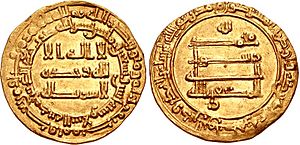| al-Muktafi | |||||
|---|---|---|---|---|---|
 Gold dinar of al-Muktafi, minted at Baghdad in 904/5 | |||||
| 17th Caliph of the Abbasid Caliphate | |||||
| Reign | 5 April 902 – 13 August 908 | ||||
| Predecessor | al-Mu'tadid | ||||
| Successor | al-Muqtadir | ||||
| Born | c. 877/8 Abbasid Caliphate | ||||
| Died | 13 August 908 (aged 31) Baghdad, Abbasid Caliphate | ||||
| Burial | Baghdad | ||||
| Consort |
| ||||
| Issue | |||||
| |||||
| Dynasty | Abbasid | ||||
| Father | al-Mu'tadid | ||||
| Mother | Jijak | ||||
| Religion | Sunni Islam | ||||
Abū Muḥammad ʿAlī ibn Aḥmad ibn Ṭalḥa ibn Jaʿfar ibn Muḥammad ibn Hārūn al-Muktafī bi'Llāh (Arabic: أبو محمد علي بن أحمد; 877/78 – 13 August 908), better known by his regnal name al-Muktafī bi-Llāh (Arabic: المكتفي بالله, lit. 'Content with God Alone'[2]), was the caliph of the Abbasid Caliphate from 902 to 908. More liberal and sedentary than his militaristic father al-Mu'tadid, al-Muktafi essentially continued his policies, although most of the actual conduct of government was left to his viziers and officials. His reign saw the defeat of the Qarmatians of the Syrian Desert, and the reincorporation of Egypt and the parts of Syria ruled by the Tulunid dynasty. The war with the Byzantine Empire continued with alternating success, although the Arabs scored a major victory in the Sack of Thessalonica in 904. His death in 908 opened the way for the installation of a weak ruler, al-Muqtadir, by the palace bureaucracy, and began the terminal decline of the Abbasid Caliphate that ended in 946 with the caliphs becoming puppet rulers under the Buyid dynasty.
- ^ a b c d e Lowry, J.E.; Toorawa, S.M. (2019). Arabic Belles Lettres. Resources in Arabic and Islamic Studies. Lockwood Press. p. 90. ISBN 978-1-948488-11-2.
- ^ Bowen 1928, p. 59.